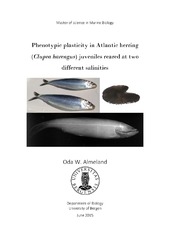Phenotypic plasticity in Atlantic herring (Clupea harengus) juveniles reared at two different salinities
| dc.contributor.author | Almeland, Oda Walle | eng |
| dc.date.accessioned | 2015-08-24T11:39:15Z | |
| dc.date.available | 2015-08-24T11:39:15Z | |
| dc.date.issued | 2015-06-01 | |
| dc.date.submitted | 2015-06-01 | eng |
| dc.identifier.uri | http://hdl.handle.net/1956/10341 | |
| dc.description.abstract | A common garden experiment with juvenile herring (Clupea harengus L.) was carried out to investigate the influence of salinity on different phenotypic traits commonly used to investigate population structure in this species. Local Atlantic spring spawning herring from western Norway was crossed with Baltic spring spawning herring to create hybrid offspring. Purebred Atlantic spring spawning offspring was also produced. The offspring of both crosses were randomly assigned and co- reared in tanks with two different salinities (16 and 35 psu). The fish were kept in the respective salinities from fertilization to final sampling 20 months later. Samples from both salinity groups were collected at day 187, 279 and 614 days post hatching (DPH). The mean (± SD) vertebrae count was higher in the purebred (56.4 ± 0.6) group than in the hybrid (55.9 ± 0.4) group, while it was not different between the two different salinities. Otolith shape developed over time from being more circular to being more oblong as the fish grew from 9 to 21 cm in total length. The otolith shape was more circular in the hybrid group, which indicate genetic effects on overall otolith shape. The ambient environment and genetic origin influenced the otolith chemistry. As an example, the otolith strontium levels (mg element weight / kg otolith weight) were higher in the 35 psu salinity, with a mean of 978 mg/kg vs 803 mg/kg in the 16 psu salinity. The purebreds within each salinity, also had a higher mean otolith strontium level of 997 mg/kg vs 876 mg/kg in the hybrids. The purebreds showed a lower survival than the hybrids, in the 16 psu salinity, before 187 DPH. The results of this study can be used to understand how the ambient salinity in the nursing areas affect the phenotype of herring and by this contributing to a better understanding of the complex population structure in herring stocks. | en_US |
| dc.format.extent | 2362945 bytes | eng |
| dc.format.mimetype | application/pdf | eng |
| dc.language.iso | eng | eng |
| dc.publisher | The University of Bergen | en_US |
| dc.rights | Copyright the Author. All rights reserved | eng |
| dc.subject | fenotypisk plastisitet | |
| dc.subject | sild | |
| dc.subject | salinitet | |
| dc.subject | Atlantic herring | eng |
| dc.subject | Clupea harengus | eng |
| dc.subject | Herring | eng |
| dc.subject | experimental study | eng |
| dc.subject | Common-garden | eng |
| dc.subject | Salinity | eng |
| dc.subject | phenotypic plasticity | eng |
| dc.subject | phenotypic traits | eng |
| dc.subject | vertebrae count | eng |
| dc.subject | Otolith | eng |
| dc.subject | otolith chemistry | eng |
| dc.subject | otolith shape | eng |
| dc.subject | Growth | eng |
| dc.subject | length-at-age | eng |
| dc.subject | otolith length | eng |
| dc.subject | SGR | eng |
| dc.subject | otolith weight | eng |
| dc.subject | otolith size | eng |
| dc.subject | Population structure | eng |
| dc.subject | population | eng |
| dc.subject | strontium | eng |
| dc.subject | ICP-MS | eng |
| dc.subject | radiography | eng |
| dc.subject | otolitter | nob |
| dc.subject | overlevelse | nob |
| dc.title | Phenotypic plasticity in Atlantic herring (Clupea harengus) juveniles reared at two different salinities | en_US |
| dc.type | Master thesis | |
| dc.description.localcode | MAMN-MAR | |
| dc.description.localcode | MAR399 | |
| dc.subject.realfagstermer | http://data.ub.uio.no/realfagstermer/c002983 | |
| dc.subject.realfagstermer | http://data.ub.uio.no/realfagstermer/c005668 | |
| dc.subject.realfagstermer | http://data.ub.uio.no/realfagstermer/c013564 | |
| dc.subject.realfagstermer | http://data.ub.uio.no/realfagstermer/c010068 | |
| dc.subject.realfagstermer | http://data.ub.uio.no/realfagstermer/c013675 | |
| dc.subject.nus | 751599 | eng |
| fs.subjectcode | MAR399 |
